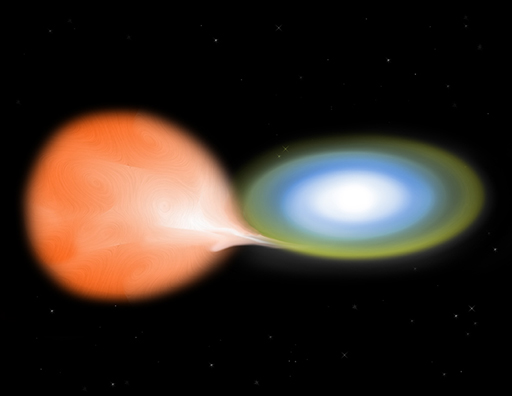2.3 Supernovae and cataclysmic variables
In the final segment of Jo’s video she describes the explosion of a supergiant star, such as Betelgeuse. These massive stars end their lives in a colossal explosion triggered by the collapse of the core when all nuclear fuel is exhausted. In the process most of the star is destroyed, with material rich in heavier elements thrown off into the interstellar medium. Only a small inner core remains, eventually collapsing to form a neutron star or even a black hole. The expanding cloud of gas thrown off in these supernova explosions forms a nebula known as a supernova remnant. The Crab Nebula (M1) that you first saw in Week 4 is a classic example of a supernova remnant.
While a supernova is a one-off and very catastrophic explosion, the term cataclysmic variable primarily refers to a type of binary system in which one component is a white dwarf, in orbit with a low-mass main sequence companion star.

In this type of system, material from the outer layers of the companion star falls onto the surface of the white dwarf, building up density and pressure. Since this material contains a lot of hydrogen the increase in density, temperature and pressure eventually triggers an outburst of nuclear fusion, producing an explosion that can cause the brightness of the binary system to briefly increase by hundreds of thousands of times (a classical nova). In some systems the process of accretion and explosion can occur repeatedly, producing a cataclysmic variable star with periodic, if perhaps irregular, outbursts. These are known as recurrent novae.
Activity _unit8.3.1 Activity 3 Hydrogen in companion star
Why is the accreting material from the companion star rich in hydrogen ?
Answer
This material is from the outer layers of the companion star. Nuclear fusion normally only occurs in the cores of stars, so although the main sequence companion is converting its core hydrogen to helium, the outer layers still contain a significant quantity of unused hydrogen.
